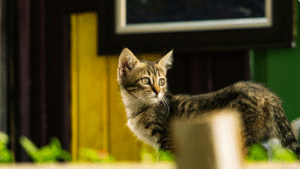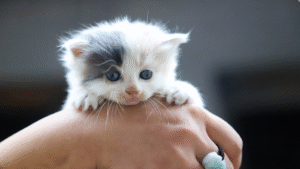Congratulations! By bringing home a new kitten, you’ve started an exciting new chapter in your life. Kittens are cute, fluffy bundles of energy that will soon provide years of loyal companionship.
Except when they’re not pooping in their litter box. And then you might start wishing they’d moved in with your neighbor instead.
Stubborn kittens can drive even the most patient owners crazy—but rest assured, litter training is absolutely possible. The first step is understanding why your kitten isn’t going where you want them to. This guide will give you the tools and tips you need to finally crack the litter box code.

1. Get the Litter Box Location and Size Right
You might think that any litter box is good enough. However, according to cat experts, the size, type, and location of the box have a major impact on whether your kitten will use it or not.
Here’s what to remember:
-
Size matters: Kittens are small but grow fast. If the litter box is too small, they can’t turn around comfortably. If it’s too big, they may feel lost. A medium-sized box with low sides for easy access is ideal.
-
Covered vs. uncovered: Covered litter boxes are great for odor control but can feel confining to kittens. Many prefer the openness of an uncovered box, so start with an open design until they’re used to the idea.
-
Quiet, private area: Like all cats, kittens prefer to do their business in peace. Place the litter box in a low-traffic area, away from food, water, and loud appliances. Laundry rooms, bathrooms, or quiet living room corners work well.
-
Easy access for young kittens: For kittens under six weeks old, keep the box near their main play or sleeping area. They have small bladders and may not make it in time if it’s too far away.
Pro tip: If you live in a multi-story home, place a litter box on each floor to ensure your kitten always has easy access.
2. Experiment with Cat Litter Types
Believe it or not, different cats have different preferences when it comes to litter texture and smell. Your kitten is no exception.
Try these options:
-
Clumping clay litter: Popular and easy to clean, but some kittens find it dusty or too rough.
-
Non-clumping clay litter: Softer and ideal for small kittens who might accidentally ingest litter.
-
Paper, wood, or corn litter: Environmentally friendly and gentle on tiny paws, though some cats dislike the texture.
-
Unscented litter: Cats have extremely sensitive noses and can be overwhelmed by heavily scented litters. Stick to unscented varieties during training.
If your kitten refuses to use the litter box, try switching up the litter type. Gently mix the new litter with the old one until your kitten gets used to the new texture.
Remember: Comfort and familiarity are key. Once your kitten settles on a litter they like, stick with it.
3. Keep the Litter Box Clean at All Times
Cleanliness is a top priority when litter training your kitten. Cats are fastidious animals, and an unclean litter box is the number one reason a kitten won’t use it. Think about it—would you want to use a dirty bathroom?
Cleaning tips for litter box success:
-
Scoop once or twice a day to remove waste.
-
Once a week, empty all the litter and clean the box with mild soap and warm water. Refill it with fresh litter afterward. Avoid harsh chemicals or bleach, as the strong smell will repel your kitten.
-
Maintain the right litter depth. Most kittens prefer about two inches of litter in the box.
If your kitten is scratching around the box but not going inside, it could mean the box smells—even if it looks clean to you.

4. Use Positive Association
Punishing a kitten for accidents is a big mistake during litter training. Cats don’t associate punishment with their behavior, so scolding will only make them fearful, anxious, and more likely to have accidents.
Instead, use positive reinforcement:
-
Reward success: When your kitten uses the litter box correctly, offer gentle praise or a small treat right away. Cats respond best to instant feedback.
-
Play near the litter box: Spend time or play near the litter box area so your kitten sees it as a safe and familiar place.
-
Avoid negative reactions: If you catch them going outside the box, gently pick them up and place them inside it. Don’t yell, clap, or rub their nose in the mess.
The goal is to make the litter box a safe, rewarding space—not somewhere they associate with fear.
5. Identify and Remove Triggers
Sometimes your kitten will use the litter box for a while and then suddenly stop. When that happens, something in their environment—or their health—may have changed.
Common triggers include:
-
Loud noises or sudden movements near the litter box, like slamming doors or noisy washing machines.
-
Strong or unfamiliar litter odors after switching brands.
-
A dirty box or overcrowding: The general rule is one box per cat, plus one extra.
-
Stress or anxiety: New pets, new furniture, or frequent visitors can unsettle kittens.
If your kitten consistently avoids the litter box, consult your veterinarian. Health issues like urinary tract infections, bladder inflammation, or digestive problems can make litter box use painful. Your kitten may then associate the box with discomfort.

6. Use Training Aids and Attractants
Sometimes, a little extra encouragement is all your kitten needs to get the hang of litter training. Cat attractant products are specifically designed to draw cats to their litter boxes.
Training aids to try:
-
Litter attractants: Powders or granules that contain scents cats naturally like (such as herbs and plant extracts). Sprinkle a small amount in the litter to entice your kitten.
-
Litter mats: Placing a soft mat outside the box keeps paws clean and creates a comfortable transition area.
-
Training sprays: These can help neutralize odors where your kitten has had accidents and discourage them from going there again.
Important: Always clean accident spots with an enzymatic cleaner. Regular soap, water, or vinegar won’t fully eliminate odors for cats, and they’ll likely return to the same spot.
7. Be Patient and Persistent
The final—and perhaps most important—tip is patience. Some kittens are quick learners, while others take longer. Consistency and calmness will turn small improvements into lasting habits.
Tips for staying consistent:
-
Keep the litter box in the same place during training. Moving it too soon can confuse your kitten.
-
Stick to a regular feeding and playtime schedule. Cats thrive on routine.
-
Be observant—most kittens need to eliminate soon after eating, waking up, or playing. Gently guide them to the litter box during these times.
With patience, time, and repetition, your kitten will learn that the litter box is the right place to go.

Bonus Tip: Start Early and Don’t Give Up
The best time to start litter training is as soon as your kitten comes home. The sooner you begin, the faster they’ll form good habits. However, it’s never too late to teach proper litter box behavior—even older kittens and rescue cats can learn with the right approach.
If progress feels slow, remember that accidents are part of the process. The goal isn’t perfection—it’s steady improvement.
Final Thoughts
Litter training a stubborn kitten isn’t just about keeping your floors clean—it’s also about building trust and understanding between you and your new furry family member. When you remain patient, calm, and encouraging, your kitten will feel secure enough to learn.
With time, consistency, and love, even the most stubborn kitten can become a perfectly litter-trained cat.
- Why Siamese Cats Are The Drama Queens Of The Cat World - November 12, 2025
- Best Cat Brushes Ranked By Fur Type - November 12, 2025
- DIY Cat Enrichment Toys You Can Make At Home - November 12, 2025
